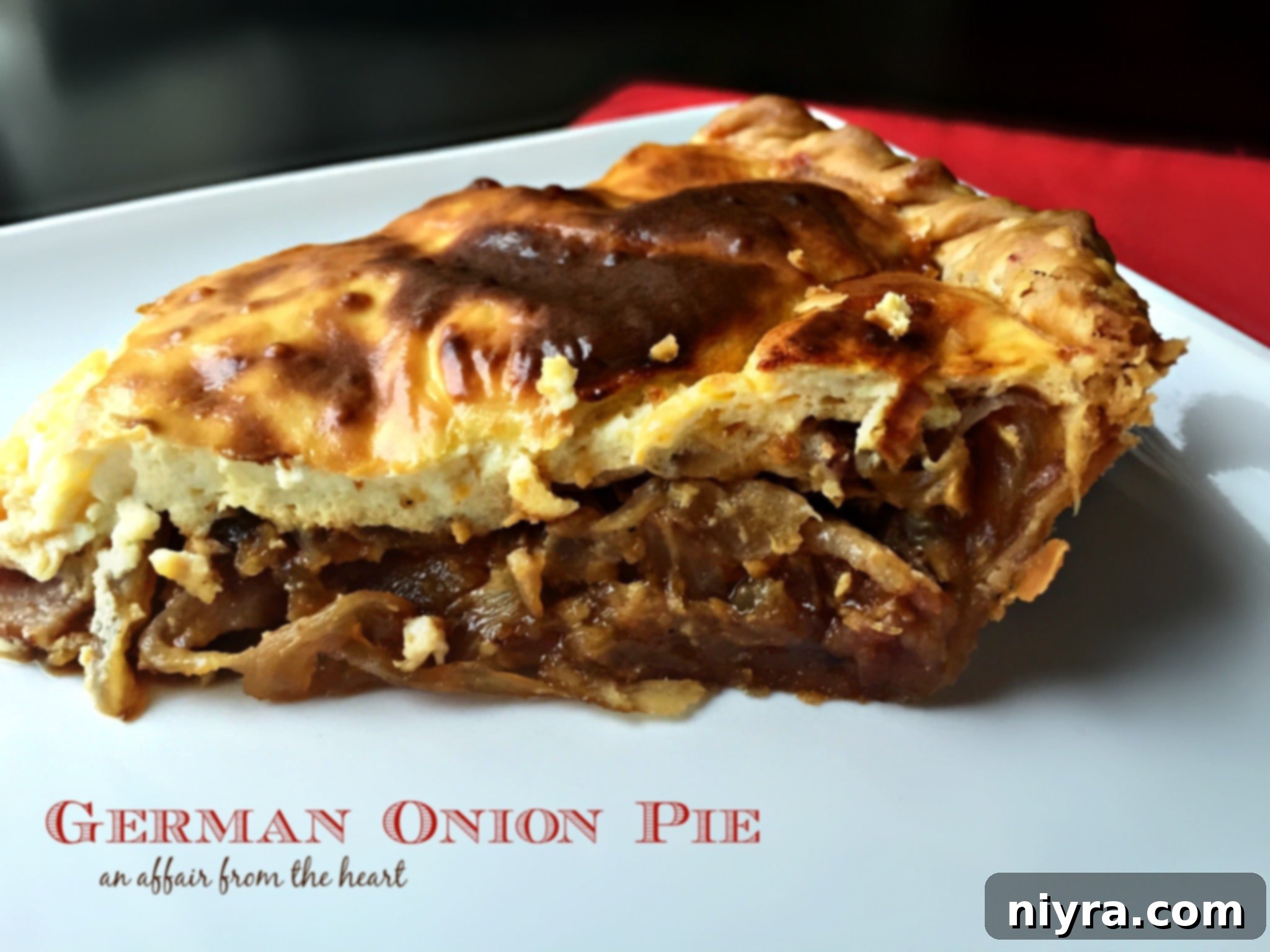Discover Zwiebelkuchen: The Savory German Onion Pie That’s Anything But Cake
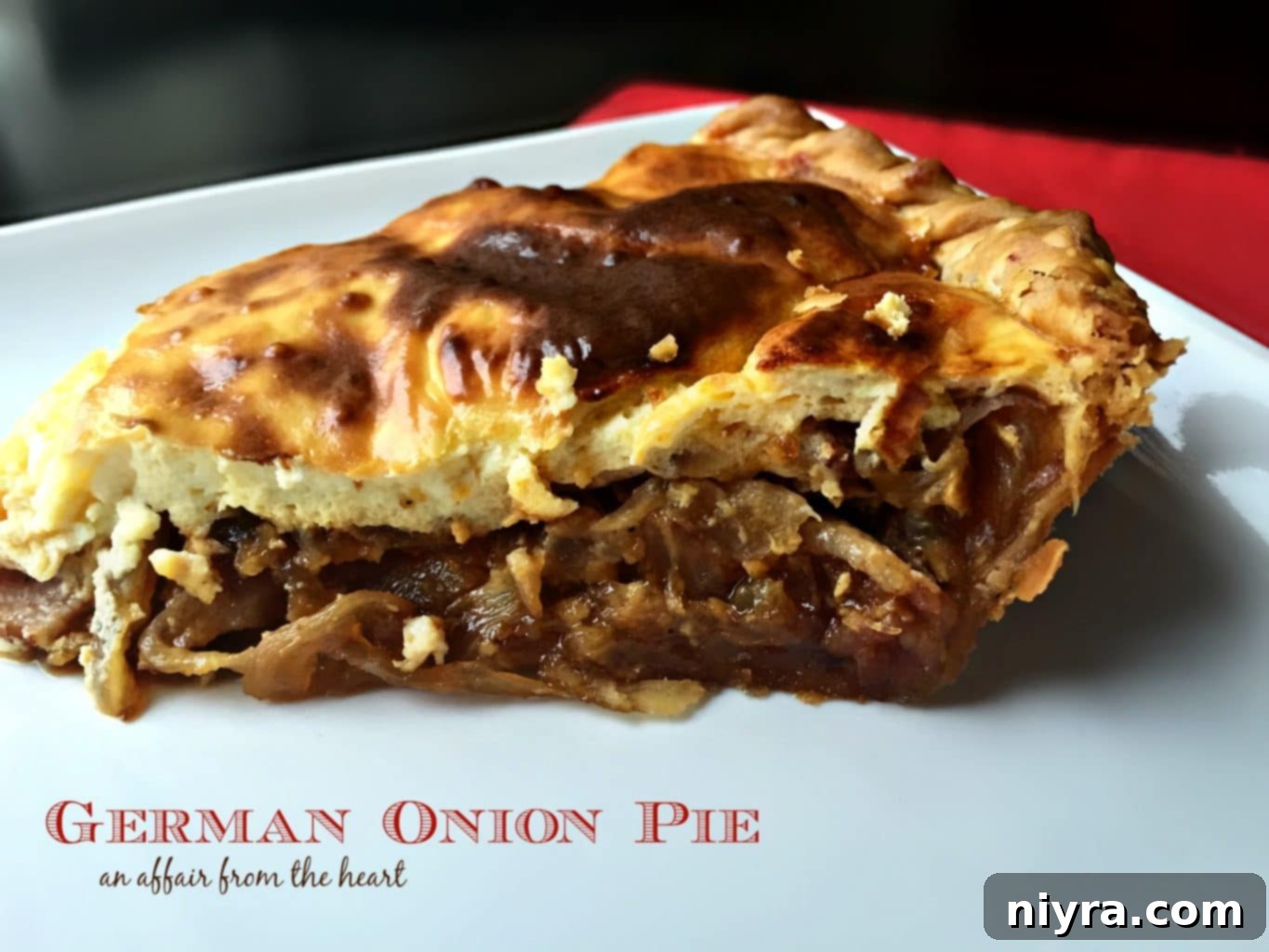
Often referred to as “Onion Cake” due to its literal translation from German, Zwiebelkuchen is a traditional savory pie that beautifully showcases the humble onion. This delightful dish, a staple at German wine festivals, is far from a sweet dessert. Instead, it’s a hearty, flavorful tart featuring a rich blend of deeply caramelized onions, smoky bacon, and a creamy egg custard, all nestled in a buttery, flaky crust. It’s a culinary experience that perfectly balances sweet and savory notes, offering comfort and robust flavor in every slice.
My journey to discovering this incredible German dish began not with my own travels, but through the vivid stories and enthusiastic recommendations of my Mom and Joe. They are seasoned travelers to Germany, having visited countless times and immersing themselves in its vibrant culture. Last year, they experienced the quintessential German celebration: Oktoberfest. Their adventures always bring back fascinating tales and, occasionally, a culinary revelation or two.

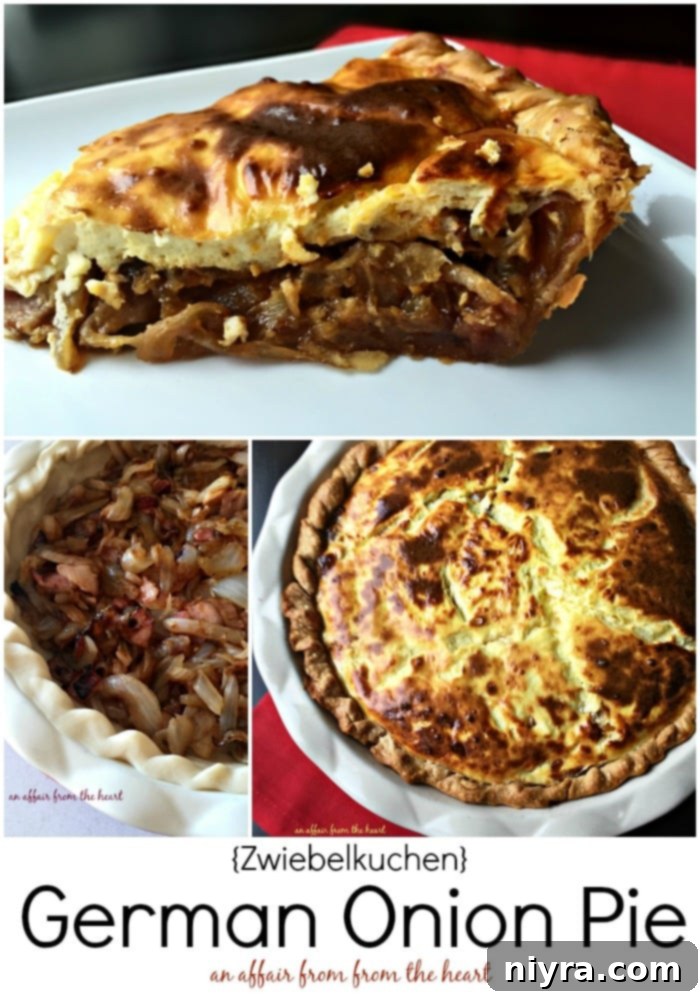
Upon their return, Joe recounted his latest culinary discovery: a wondrous “Onion Cake” they enjoyed at a charming bed and breakfast in Gau-Bickelheim, Germany. My initial reaction was a bewildered, “Onion CAKE?!?” swiftly followed by a less-than-enthusiastic “blech!” The idea of a sweet onion dessert didn’t exactly tantalize my taste buds. However, Joe quickly clarified that despite its misleading name, it was actually a savory pie, quite similar to a quiche. “Now you’re talking!” I exclaimed, my curiosity piqued and my apprehension instantly replaced with excitement. He had even managed to secure the recipe, urging me to recreate this German delicacy. I decided to wait, knowing that the sweet, mild Vidalia onions, which I adore, would soon be in season – the perfect ingredient to elevate this dish.
The Heart of Zwiebelkuchen: Caramelized Onions and Smoky Bacon

The foundation of an outstanding Zwiebelkuchen lies in its onions. This recipe calls for a substantial two pounds of onions, which might seem like an enormous quantity at first glance. However, anyone who has ever caramelized onions knows just how dramatically they reduce in volume as they cook down. What begins as a mountain of pungent, crisp onion slices transforms into a rich, sweet, and incredibly tender base. This reduction concentrates their natural sugars, creating a depth of flavor that is absolutely essential to the pie’s character.
The cooking process is simple yet transformative. We start by sautéing the chopped bacon, allowing its fat to render and create a flavorful foundation. This rendered bacon fat is the only additional fat needed to cook the onions, infusing them with a delicious smokiness from the very beginning. As the onions slowly cook with the bacon, they soften and release their moisture, gradually turning golden brown and achieving that coveted caramelized sweetness. Patience is key here; don’t rush this step, as it’s where the magic truly happens.
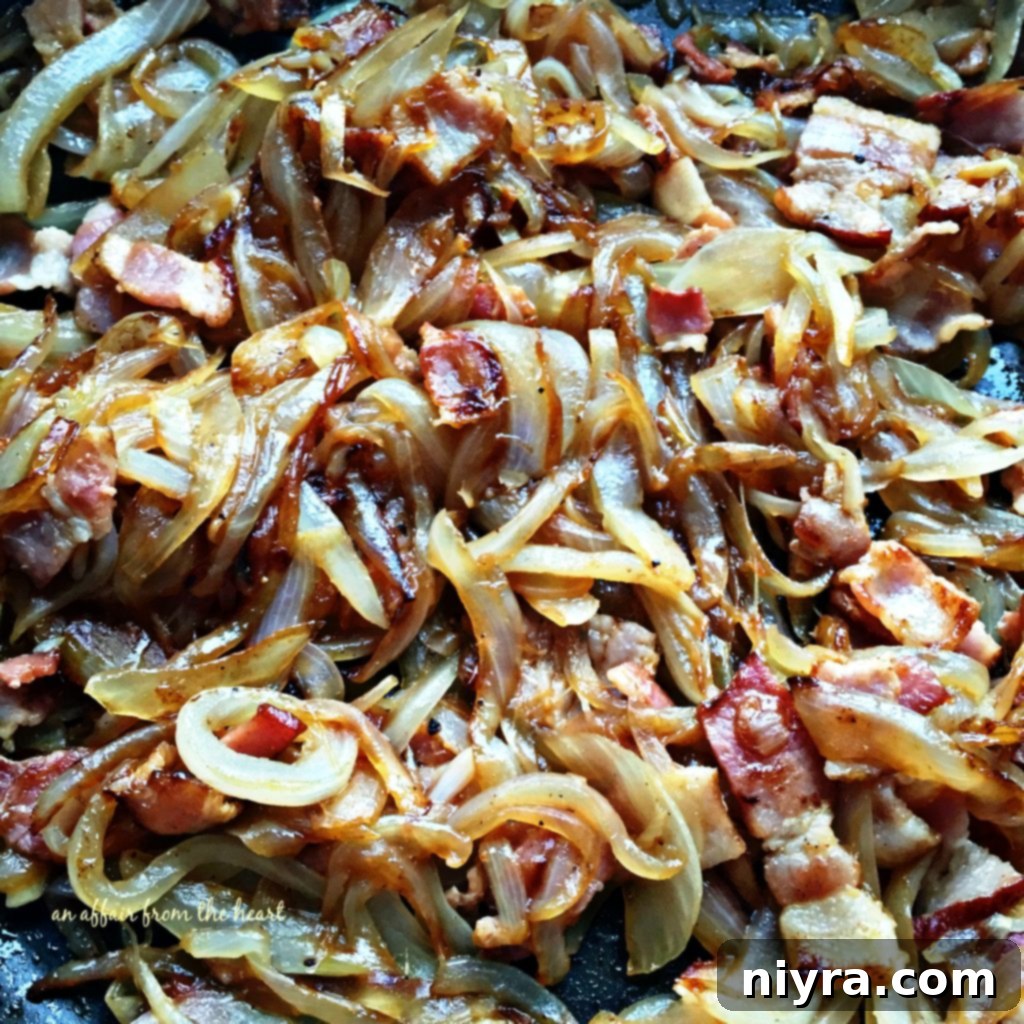
Once the onions have reached a beautiful caramel color and the bacon is crispy, a light sprinkling of paprika and salt enhances their savory profile. This mixture, a symphony of sweet, smoky, and salty notes, is now ready to be transferred to the waiting pie crust. The aroma filling your kitchen at this stage is nothing short of heavenly – a promising preview of the deliciousness to come.
Assembling and Baking Your German Onion Pie
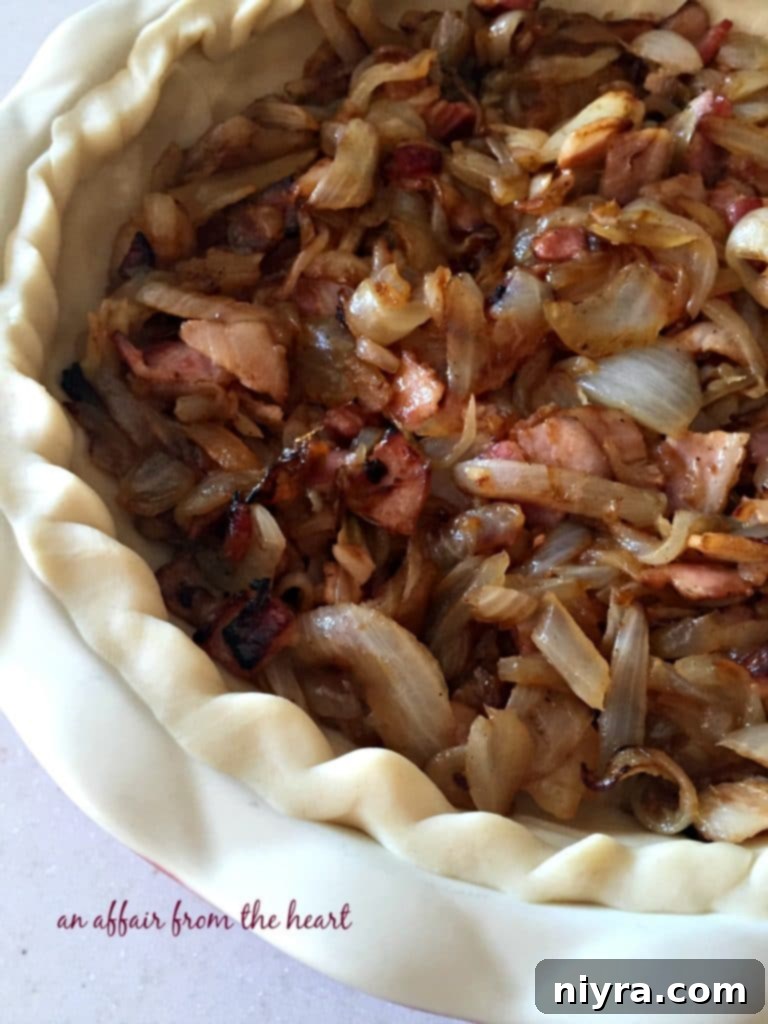
With your caramelized onion and bacon filling prepared, the next step is to carefully spoon it into your pie crust. The generous quantity will fill the crust generously, creating a substantial base for this savory tart. While you’re enjoying the incredible aroma, you can almost taste the rich, comforting flavors of Germany.
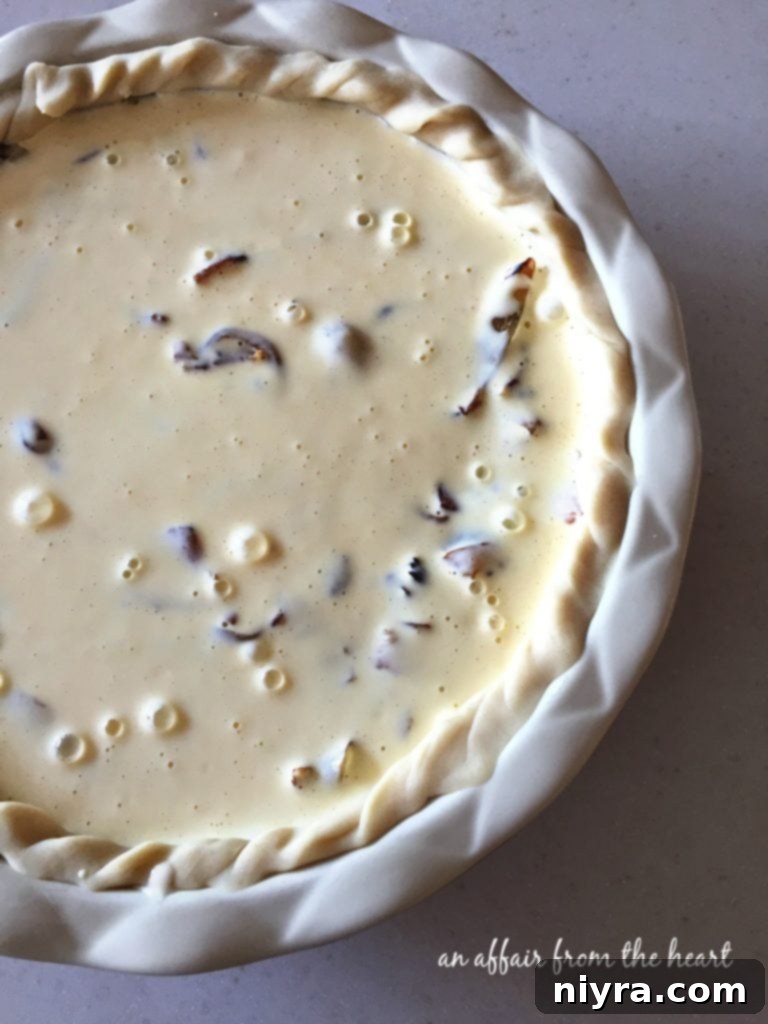
The final touch before baking is the creamy, savory custard. In a separate bowl, whisk together the sour cream and eggs, lightly seasoning the mixture. This combination creates a rich, tangy custard that binds the filling together and adds a luxurious texture. Pour this egg mixture evenly over the onion and bacon, ensuring it seeps into all the crevices. For an authentic German touch, you might consider sprinkling a few caraway seeds over the top. While optional, caraway seeds add a distinctive, warm, and slightly peppery flavor that many traditional Zwiebelkuchen recipes feature. However, if they’re not to your taste, the pie is equally delicious without them.
The pie then bakes in a preheated oven at 400 degrees Fahrenheit (200 degrees Celsius) for approximately 40 minutes. Keep an eye on it towards the end of the baking time; the top should become beautifully golden brown. I initially worried mine was getting too dark, but my Mom reassured me, saying it looked just like the delicious Zwiebelkuchen they had enjoyed in Gau-Bickelheim. Once baked, it’s crucial to let the pie rest for about 5 minutes before slicing. This allows the custard to fully set, ensuring clean, elegant slices that hold their shape perfectly.
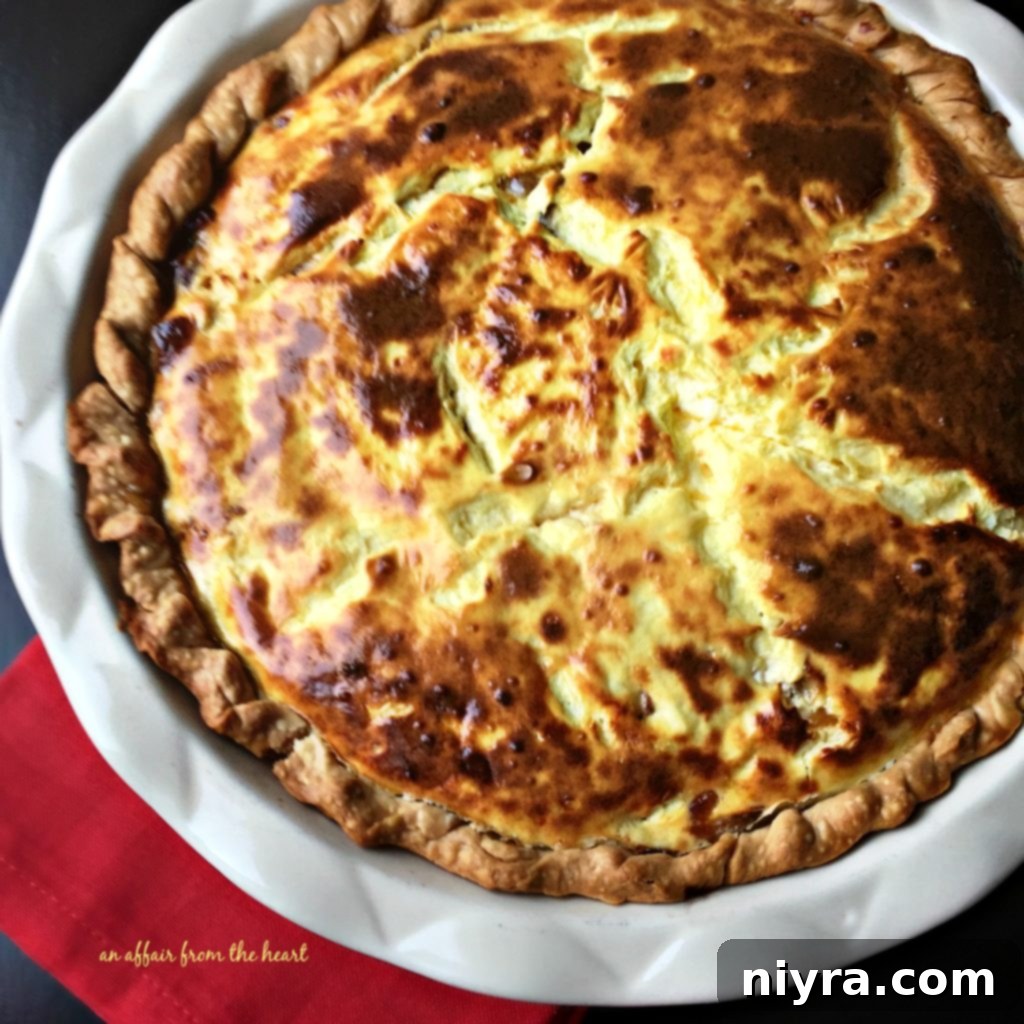
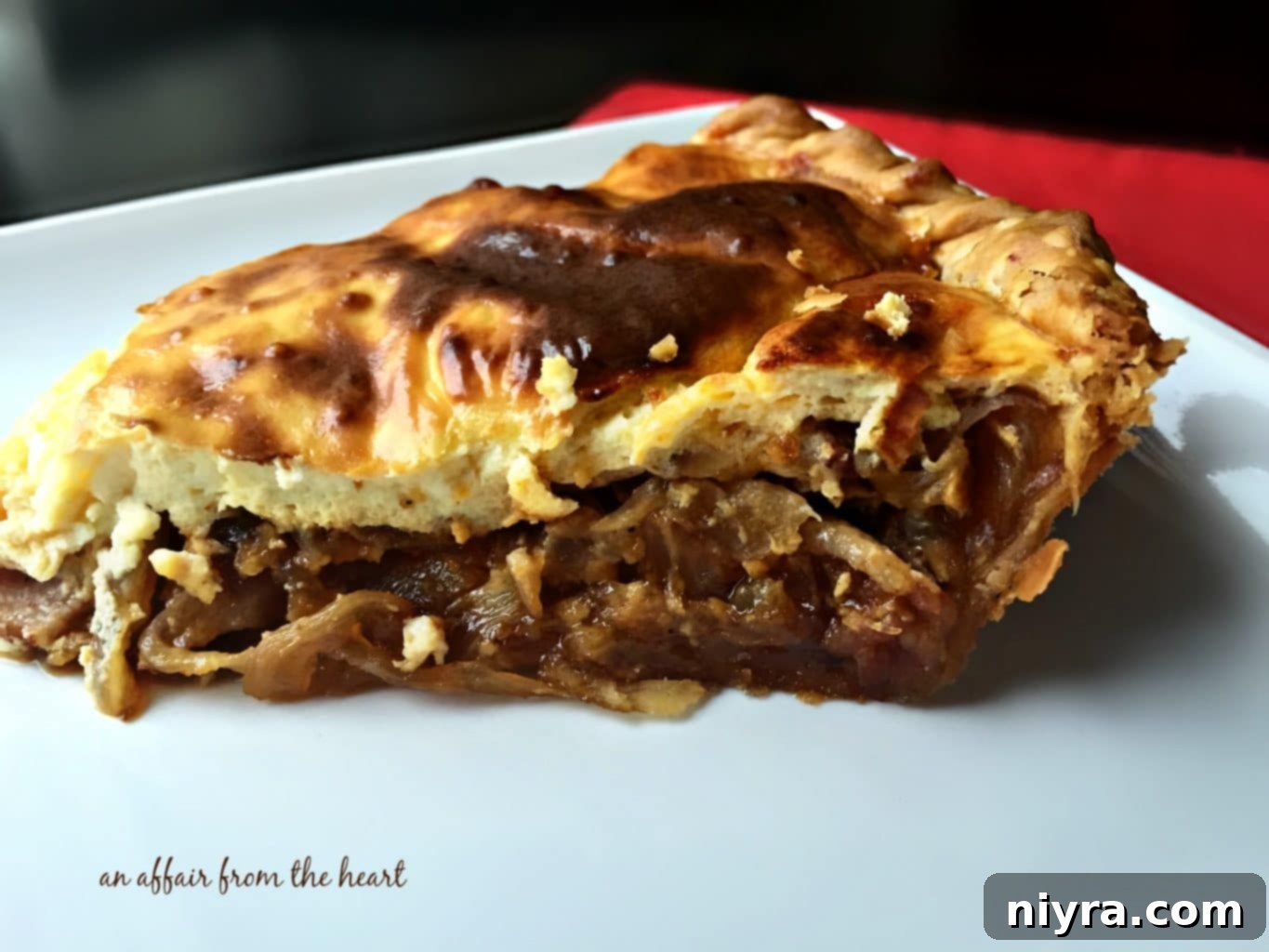
The result is a truly wonderful meal that brings a taste of German tradition right to your table. Its hearty nature makes it perfect for a cozy dinner, a festive brunch, or even as an impressive appetizer. This Zwiebelkuchen has quickly become a family favorite, and I’m certain it will be a regular feature in our meal rotation for years to come.
Why Zwiebelkuchen Deserves a Spot in Your Culinary Repertoire
Beyond its delicious taste, Zwiebelkuchen offers a unique blend of simplicity and sophistication. It’s a dish that celebrates humble ingredients, transforming them through careful preparation into something extraordinary. The combination of sweet caramelized onions, savory bacon, and a creamy, slightly tangy egg custard creates a harmonious flavor profile that is both comforting and exciting. It’s an excellent choice for a variety of occasions, from a casual weeknight meal to a special gathering with friends and family.
Traditionally, Zwiebelkuchen is enjoyed in autumn, especially alongside Federweißer, a young, partially fermented white wine. The slight sweetness and effervescence of the wine beautifully complement the rich, savory notes of the onion pie. However, it’s equally delightful with a crisp lager, a dry white wine, or even a simple green salad for a lighter meal. Its versatility means it can be served warm or at room temperature, making it ideal for potlucks and picnics.
Tips for Zwiebelkuchen Perfection and Variations to Explore
While this recipe provides a fantastic base, there are a few tips and variations you might consider to make your Zwiebelkuchen truly shine:
- Onion Choice: While Vidalia onions offer a delightful sweetness, regular yellow or sweet onions work wonderfully too. The key is to caramelize them slowly to bring out their natural sugars.
- Crust Protection: To prevent a soggy bottom, especially if you’re using a store-bought crust, you might want to consider pre-baking it slightly. This helps create a barrier between the moist filling and the pastry. For detailed instructions, refer to guides on how to pre-bake pie crust.
- Bacon Finesse: While my initial attempt used larger bacon pieces, some traditional recipes suggest chopping the bacon a little finer to integrate more evenly throughout the filling. Experiment to see which texture you prefer!
- Springform Pan Alternative: While a 9-inch deep-dish pie plate works perfectly, some German versions of Zwiebelkuchen are baked in a springform pan, which gives the pie straighter, taller sides, similar to a cake. This can offer a different presentation and texture, especially for the crust.
- Herbs and Spices: Beyond paprika and optional caraway seeds, you could experiment with a pinch of nutmeg, a dash of white pepper, or fresh thyme for an added layer of aroma and flavor.
- Cheese: Although not traditional, a sprinkle of grated Gruyère or Emmental cheese over the filling before pouring the custard can add an extra layer of richness and flavor.
Learning about the background of this recipe, comparing it to other versions, and experimenting with small tweaks has been a truly rewarding experience. For those interested in exploring a more traditional approach, I highly recommend reading comprehensive write-ups from other culinary experts. For example, The Daring Gourmet’s Zwiebelkuchen (German Onion Pie) offers valuable insights into its history and preparation methods.
If you’ve enjoyed delving into the world of German cuisine with this Zwiebelkuchen, I encourage you to explore my other German recipes. There’s a rich tapestry of flavors waiting to be discovered, from hearty main courses to delightful desserts. Whether it’s the savory depth of this onion pie or another classic German dish, you’re sure to find something that brings a unique taste of Germany to your home kitchen.
LIKE THIS RECIPE?
Don’t forget to give it a ⭐⭐⭐⭐⭐ star rating and
leave a comment below the recipe!

German Onion Pie (Zwiebelkuchen)
This savory Onion Pie is known as Zwiebelkuchen in Germany, translating to “Onion Cake.” It’s a pie with caramelized onions, bacon and topped with an egg mixture.
Ingredients
- 1 pie crust
- 2 pounds onions (sliced or chopped)
- 5 ounces bacon (chopped)
- 1 cup sour cream
- 4 eggs
- paprika
- salt
- caraway seeds (optional)
Instructions
- Preheat oven to 400 degrees F (200 degrees C).
- Line a 9″ deep dish pie plate with a pie crust. Set aside.
- Sauté onions and bacon until onions are a nice caramel color and bacon is cooked. Give it a sprinkling of paprika and salt.
- Pour onion/bacon mixture into the pie crust.
- Mix sour cream and eggs together and pour over the onion mixture.
- (If you are using caraway seeds, sprinkle some over the top)
- Bake for 40 minutes. Let set for 5 minutes before slicing.
Notes
I did not use caraway seeds, as I am not a fan. If you love them, I would sprinkle some on!
